Report on Critical Thinking and Training Problem Analysis in Business
VerifiedAdded on 2022/08/18
|10
|2241
|10
Report
AI Summary
This report presents an analysis of two critical thinking activities and a training problem, alongside an evaluation of mobile device extraction methods. The first part assesses listening skills, identifying characteristics of good listeners and analyzing personal listening habits. The second part explores a training problem within a corporate setting, outlining the steps Amanda Carr should take to conduct a training needs assessment, develop objectives, and implement a successful training program, focusing on quality planning, control, and improvement. The report also addresses potential obstacles, like resistance to change and lack of management participation, and proposes solutions. Additionally, the report evaluates logical, file system, and physical extraction methods using Cellebrite UFED4PC and Physical Analyzer, highlighting their characteristics, strengths, and weaknesses, and the range of data they return. The analysis is based on the student's responses to the assignment brief which included critical thinking activities and the mobile device investigation.
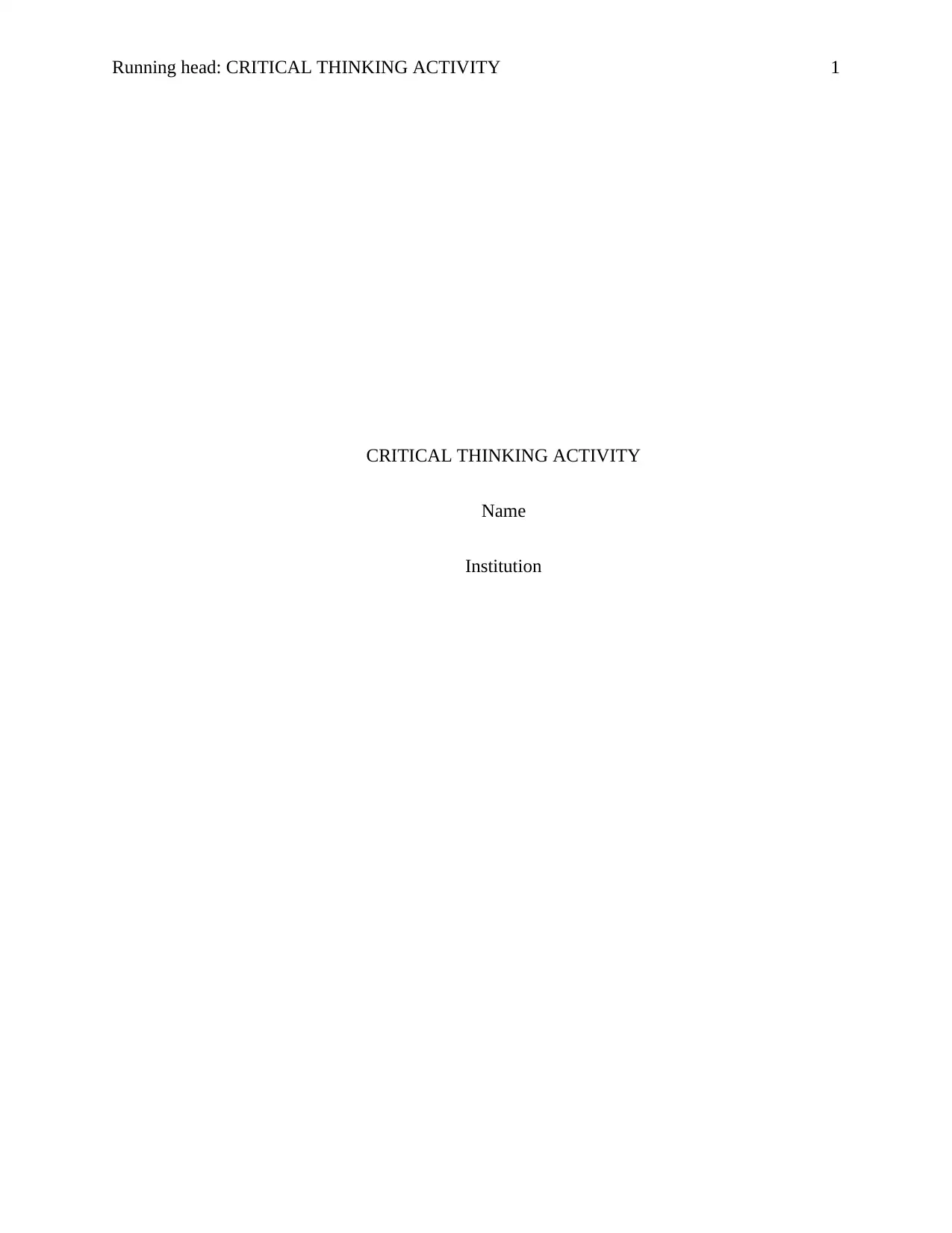
Running head: CRITICAL THINKING ACTIVITY 1
CRITICAL THINKING ACTIVITY
Name
Institution
CRITICAL THINKING ACTIVITY
Name
Institution
Paraphrase This Document
Need a fresh take? Get an instant paraphrase of this document with our AI Paraphraser

CRITICAL THINKING ACTIVITY 2
CRITICAL THINKING
Critical Thinking Activity (Are You A Good Listener?)
Introduction
Listening is one of the vital aspects of communication. The quality of communication and
understanding depends on the recipient's listening skills. The difference in listening skills is the
reason why a group of people can receive the same communication, and each gets a different
message. Listening affects the effectiveness and ease of communication; some behaviors from
listeners promote the effectiveness of communication while others block effective
communication. Good listeners have some defining characteristics, and these can be evaluated
using the activity questions answered immediately after the introduction.
Listening skills assessment
Question
Response
Yes No
1. When in a group of people, do you talk more than you listen? ×
2. When talking with someone, do you frequently interrupt before he or she completes a
statement?
×
3. In conversations, do you tune out and think ahead to your response? ×
4. In a typical conversation, can you paraphrase what the speaker has said and repeat it? ×
5. When talking, do you frequently state your opinion before the other parties have
made their case?
×
6. Do you continue doing other tasks when someone is talking to you? ×
7. Do you ask for clarification when you don’t understand what has been said? ×
CRITICAL THINKING
Critical Thinking Activity (Are You A Good Listener?)
Introduction
Listening is one of the vital aspects of communication. The quality of communication and
understanding depends on the recipient's listening skills. The difference in listening skills is the
reason why a group of people can receive the same communication, and each gets a different
message. Listening affects the effectiveness and ease of communication; some behaviors from
listeners promote the effectiveness of communication while others block effective
communication. Good listeners have some defining characteristics, and these can be evaluated
using the activity questions answered immediately after the introduction.
Listening skills assessment
Question
Response
Yes No
1. When in a group of people, do you talk more than you listen? ×
2. When talking with someone, do you frequently interrupt before he or she completes a
statement?
×
3. In conversations, do you tune out and think ahead to your response? ×
4. In a typical conversation, can you paraphrase what the speaker has said and repeat it? ×
5. When talking, do you frequently state your opinion before the other parties have
made their case?
×
6. Do you continue doing other tasks when someone is talking to you? ×
7. Do you ask for clarification when you don’t understand what has been said? ×
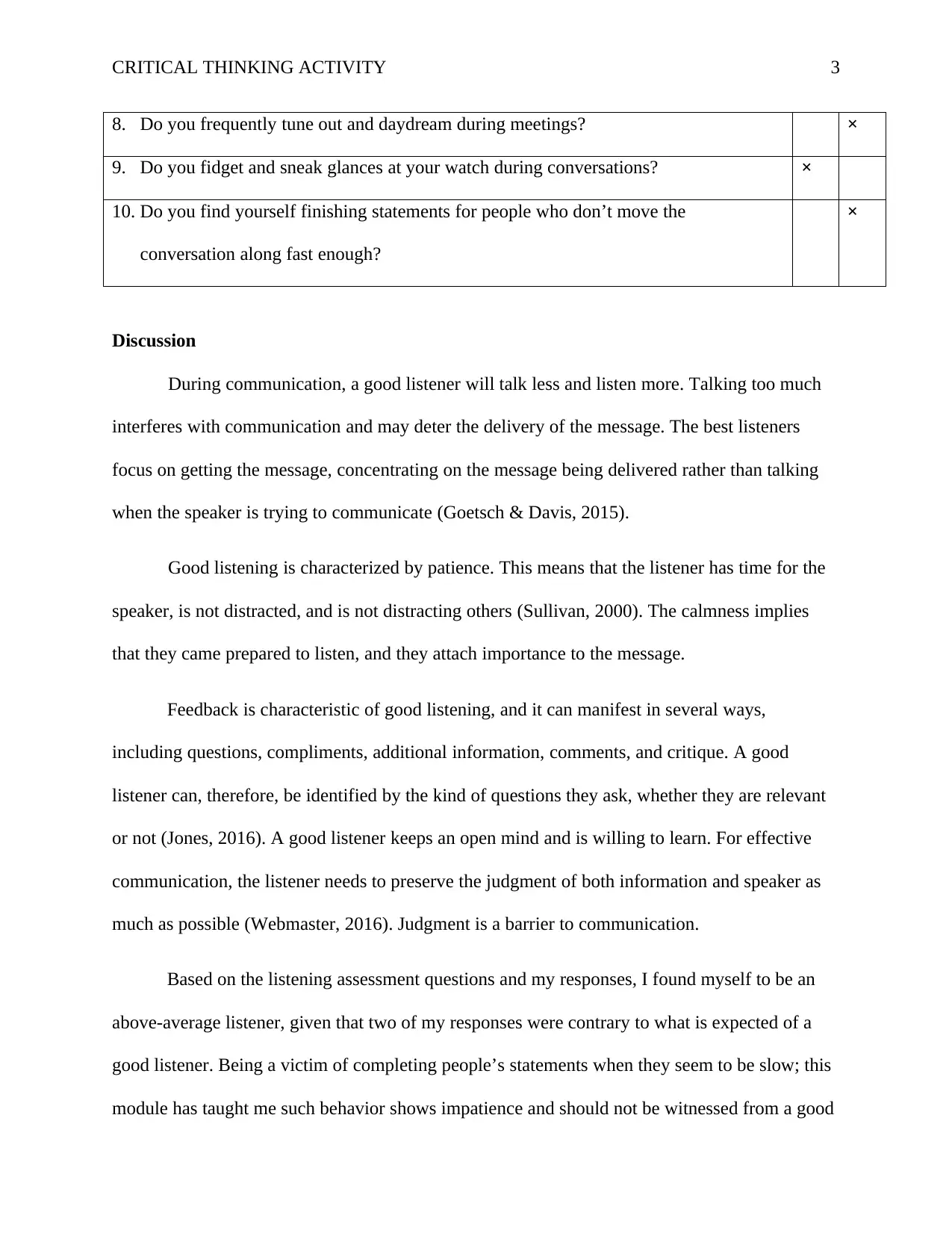
CRITICAL THINKING ACTIVITY 3
8. Do you frequently tune out and daydream during meetings? ×
9. Do you fidget and sneak glances at your watch during conversations? ×
10. Do you find yourself finishing statements for people who don’t move the
conversation along fast enough?
×
Discussion
During communication, a good listener will talk less and listen more. Talking too much
interferes with communication and may deter the delivery of the message. The best listeners
focus on getting the message, concentrating on the message being delivered rather than talking
when the speaker is trying to communicate (Goetsch & Davis, 2015).
Good listening is characterized by patience. This means that the listener has time for the
speaker, is not distracted, and is not distracting others (Sullivan, 2000). The calmness implies
that they came prepared to listen, and they attach importance to the message.
Feedback is characteristic of good listening, and it can manifest in several ways,
including questions, compliments, additional information, comments, and critique. A good
listener can, therefore, be identified by the kind of questions they ask, whether they are relevant
or not (Jones, 2016). A good listener keeps an open mind and is willing to learn. For effective
communication, the listener needs to preserve the judgment of both information and speaker as
much as possible (Webmaster, 2016). Judgment is a barrier to communication.
Based on the listening assessment questions and my responses, I found myself to be an
above-average listener, given that two of my responses were contrary to what is expected of a
good listener. Being a victim of completing people’s statements when they seem to be slow; this
module has taught me such behavior shows impatience and should not be witnessed from a good
8. Do you frequently tune out and daydream during meetings? ×
9. Do you fidget and sneak glances at your watch during conversations? ×
10. Do you find yourself finishing statements for people who don’t move the
conversation along fast enough?
×
Discussion
During communication, a good listener will talk less and listen more. Talking too much
interferes with communication and may deter the delivery of the message. The best listeners
focus on getting the message, concentrating on the message being delivered rather than talking
when the speaker is trying to communicate (Goetsch & Davis, 2015).
Good listening is characterized by patience. This means that the listener has time for the
speaker, is not distracted, and is not distracting others (Sullivan, 2000). The calmness implies
that they came prepared to listen, and they attach importance to the message.
Feedback is characteristic of good listening, and it can manifest in several ways,
including questions, compliments, additional information, comments, and critique. A good
listener can, therefore, be identified by the kind of questions they ask, whether they are relevant
or not (Jones, 2016). A good listener keeps an open mind and is willing to learn. For effective
communication, the listener needs to preserve the judgment of both information and speaker as
much as possible (Webmaster, 2016). Judgment is a barrier to communication.
Based on the listening assessment questions and my responses, I found myself to be an
above-average listener, given that two of my responses were contrary to what is expected of a
good listener. Being a victim of completing people’s statements when they seem to be slow; this
module has taught me such behavior shows impatience and should not be witnessed from a good
⊘ This is a preview!⊘
Do you want full access?
Subscribe today to unlock all pages.

Trusted by 1+ million students worldwide
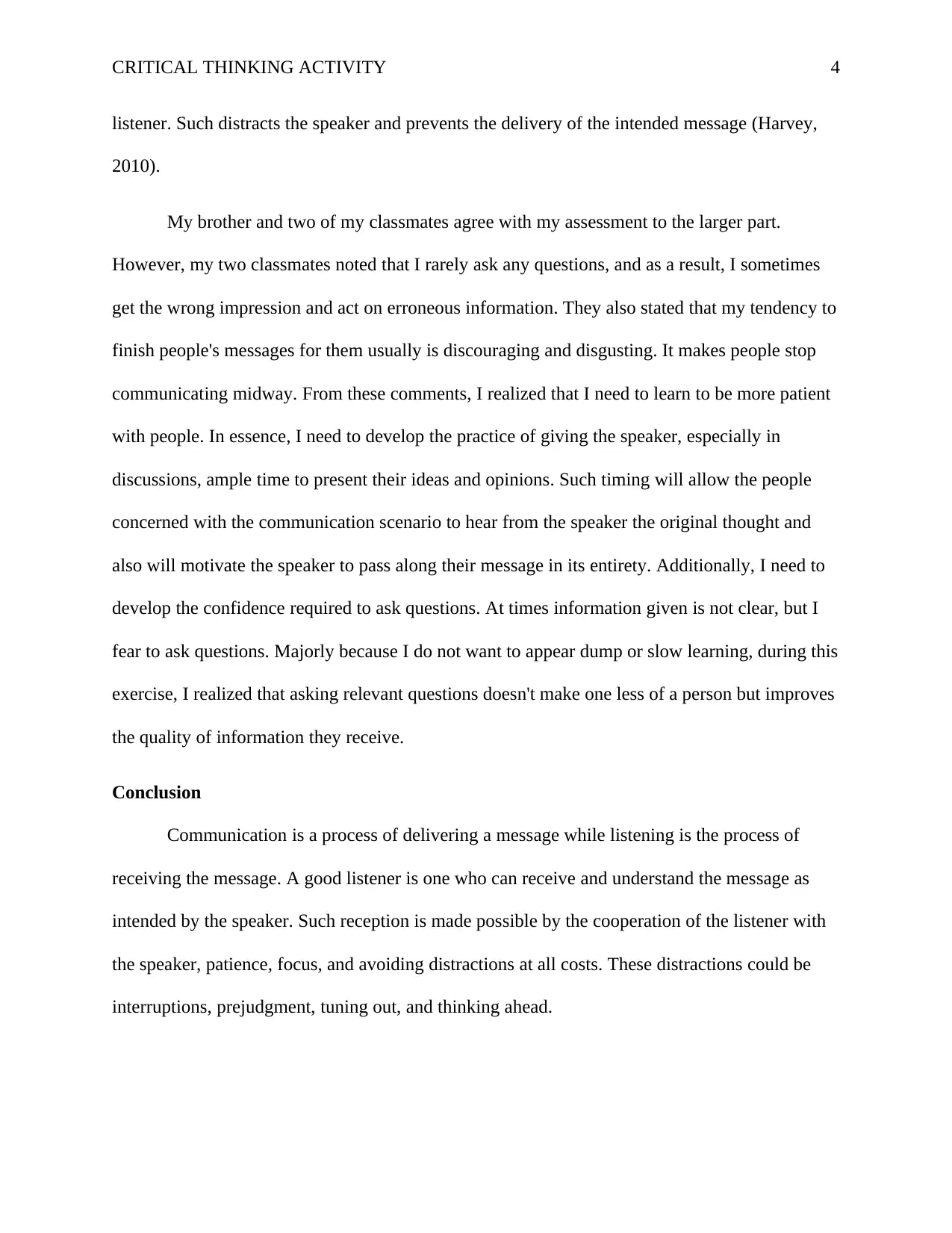
CRITICAL THINKING ACTIVITY 4
listener. Such distracts the speaker and prevents the delivery of the intended message (Harvey,
2010).
My brother and two of my classmates agree with my assessment to the larger part.
However, my two classmates noted that I rarely ask any questions, and as a result, I sometimes
get the wrong impression and act on erroneous information. They also stated that my tendency to
finish people's messages for them usually is discouraging and disgusting. It makes people stop
communicating midway. From these comments, I realized that I need to learn to be more patient
with people. In essence, I need to develop the practice of giving the speaker, especially in
discussions, ample time to present their ideas and opinions. Such timing will allow the people
concerned with the communication scenario to hear from the speaker the original thought and
also will motivate the speaker to pass along their message in its entirety. Additionally, I need to
develop the confidence required to ask questions. At times information given is not clear, but I
fear to ask questions. Majorly because I do not want to appear dump or slow learning, during this
exercise, I realized that asking relevant questions doesn't make one less of a person but improves
the quality of information they receive.
Conclusion
Communication is a process of delivering a message while listening is the process of
receiving the message. A good listener is one who can receive and understand the message as
intended by the speaker. Such reception is made possible by the cooperation of the listener with
the speaker, patience, focus, and avoiding distractions at all costs. These distractions could be
interruptions, prejudgment, tuning out, and thinking ahead.
listener. Such distracts the speaker and prevents the delivery of the intended message (Harvey,
2010).
My brother and two of my classmates agree with my assessment to the larger part.
However, my two classmates noted that I rarely ask any questions, and as a result, I sometimes
get the wrong impression and act on erroneous information. They also stated that my tendency to
finish people's messages for them usually is discouraging and disgusting. It makes people stop
communicating midway. From these comments, I realized that I need to learn to be more patient
with people. In essence, I need to develop the practice of giving the speaker, especially in
discussions, ample time to present their ideas and opinions. Such timing will allow the people
concerned with the communication scenario to hear from the speaker the original thought and
also will motivate the speaker to pass along their message in its entirety. Additionally, I need to
develop the confidence required to ask questions. At times information given is not clear, but I
fear to ask questions. Majorly because I do not want to appear dump or slow learning, during this
exercise, I realized that asking relevant questions doesn't make one less of a person but improves
the quality of information they receive.
Conclusion
Communication is a process of delivering a message while listening is the process of
receiving the message. A good listener is one who can receive and understand the message as
intended by the speaker. Such reception is made possible by the cooperation of the listener with
the speaker, patience, focus, and avoiding distractions at all costs. These distractions could be
interruptions, prejudgment, tuning out, and thinking ahead.
Paraphrase This Document
Need a fresh take? Get an instant paraphrase of this document with our AI Paraphraser

CRITICAL THINKING ACTIVITY 5
Critical Thinking Activity (A Training Problem)
Introduction
The training problem presents in most corporate institutions when there is a need to gain
knowledge and skill necessary to realize the objectives set in any project. These skills are
imparted through training, and for training to be successful, the concerned parties must be
trainable, and the trainer must know the best approach to use in practice. Training needs manifest
in different scenarios, and each situation has a training approach that can work best to produce
the desired results. Amanda Carr is faced with the challenge of training The Werner
Corporation’s managers and employees and employees to equip them with skills for actualizing
their goals. Amanda has realized that the company has excellent and realistic goals but cannot
achieve these goals.
Discussion
How Amanda Should Proceed
The first thing that Amanda must do is to conduct a thorough training needs assessment.
The assessment will be aimed at determining what skills are needed by which departments and
levels of management, what attitudes need to be changed by comparing the required standards
with the existing standards (Boydell & Leary; Hansen, 2019). For example, Amanda might ask a
question like what project management skills are needed and what project management skills do
TWC’s managers currently have? All the training needs must be tailored to specific departments
so that the time is not wasted, training everyone on a particular skill, yet only a particular
department needs the expertise (Dalto, 2014).
After identifying department-specific training needs, Amanda should convert and
integrate these needs into training objectives (Goestsch & Davis, 2015). For example, the
Critical Thinking Activity (A Training Problem)
Introduction
The training problem presents in most corporate institutions when there is a need to gain
knowledge and skill necessary to realize the objectives set in any project. These skills are
imparted through training, and for training to be successful, the concerned parties must be
trainable, and the trainer must know the best approach to use in practice. Training needs manifest
in different scenarios, and each situation has a training approach that can work best to produce
the desired results. Amanda Carr is faced with the challenge of training The Werner
Corporation’s managers and employees and employees to equip them with skills for actualizing
their goals. Amanda has realized that the company has excellent and realistic goals but cannot
achieve these goals.
Discussion
How Amanda Should Proceed
The first thing that Amanda must do is to conduct a thorough training needs assessment.
The assessment will be aimed at determining what skills are needed by which departments and
levels of management, what attitudes need to be changed by comparing the required standards
with the existing standards (Boydell & Leary; Hansen, 2019). For example, Amanda might ask a
question like what project management skills are needed and what project management skills do
TWC’s managers currently have? All the training needs must be tailored to specific departments
so that the time is not wasted, training everyone on a particular skill, yet only a particular
department needs the expertise (Dalto, 2014).
After identifying department-specific training needs, Amanda should convert and
integrate these needs into training objectives (Goestsch & Davis, 2015). For example, the
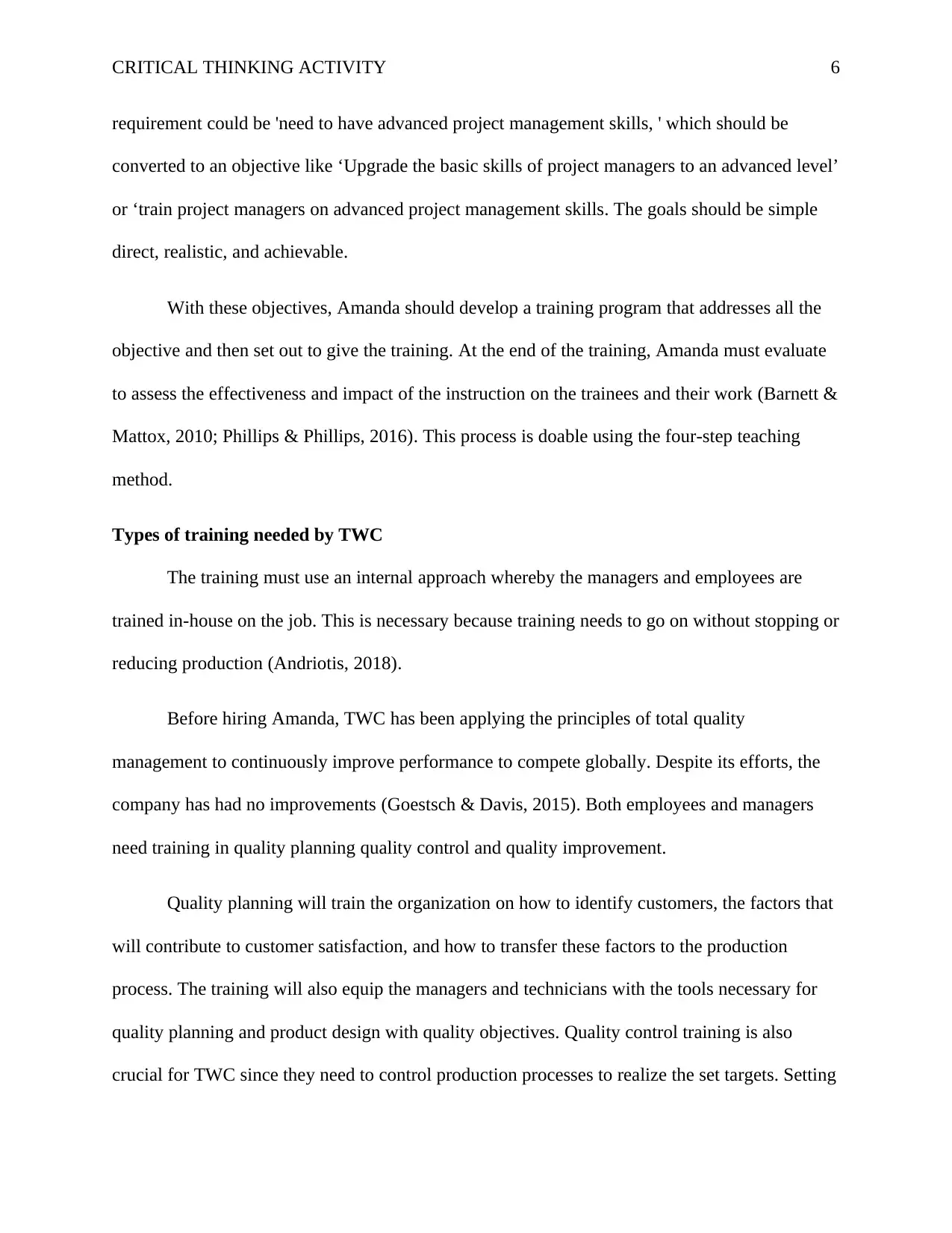
CRITICAL THINKING ACTIVITY 6
requirement could be 'need to have advanced project management skills, ' which should be
converted to an objective like ‘Upgrade the basic skills of project managers to an advanced level’
or ‘train project managers on advanced project management skills. The goals should be simple
direct, realistic, and achievable.
With these objectives, Amanda should develop a training program that addresses all the
objective and then set out to give the training. At the end of the training, Amanda must evaluate
to assess the effectiveness and impact of the instruction on the trainees and their work (Barnett &
Mattox, 2010; Phillips & Phillips, 2016). This process is doable using the four-step teaching
method.
Types of training needed by TWC
The training must use an internal approach whereby the managers and employees are
trained in-house on the job. This is necessary because training needs to go on without stopping or
reducing production (Andriotis, 2018).
Before hiring Amanda, TWC has been applying the principles of total quality
management to continuously improve performance to compete globally. Despite its efforts, the
company has had no improvements (Goestsch & Davis, 2015). Both employees and managers
need training in quality planning quality control and quality improvement.
Quality planning will train the organization on how to identify customers, the factors that
will contribute to customer satisfaction, and how to transfer these factors to the production
process. The training will also equip the managers and technicians with the tools necessary for
quality planning and product design with quality objectives. Quality control training is also
crucial for TWC since they need to control production processes to realize the set targets. Setting
requirement could be 'need to have advanced project management skills, ' which should be
converted to an objective like ‘Upgrade the basic skills of project managers to an advanced level’
or ‘train project managers on advanced project management skills. The goals should be simple
direct, realistic, and achievable.
With these objectives, Amanda should develop a training program that addresses all the
objective and then set out to give the training. At the end of the training, Amanda must evaluate
to assess the effectiveness and impact of the instruction on the trainees and their work (Barnett &
Mattox, 2010; Phillips & Phillips, 2016). This process is doable using the four-step teaching
method.
Types of training needed by TWC
The training must use an internal approach whereby the managers and employees are
trained in-house on the job. This is necessary because training needs to go on without stopping or
reducing production (Andriotis, 2018).
Before hiring Amanda, TWC has been applying the principles of total quality
management to continuously improve performance to compete globally. Despite its efforts, the
company has had no improvements (Goestsch & Davis, 2015). Both employees and managers
need training in quality planning quality control and quality improvement.
Quality planning will train the organization on how to identify customers, the factors that
will contribute to customer satisfaction, and how to transfer these factors to the production
process. The training will also equip the managers and technicians with the tools necessary for
quality planning and product design with quality objectives. Quality control training is also
crucial for TWC since they need to control production processes to realize the set targets. Setting
⊘ This is a preview!⊘
Do you want full access?
Subscribe today to unlock all pages.

Trusted by 1+ million students worldwide
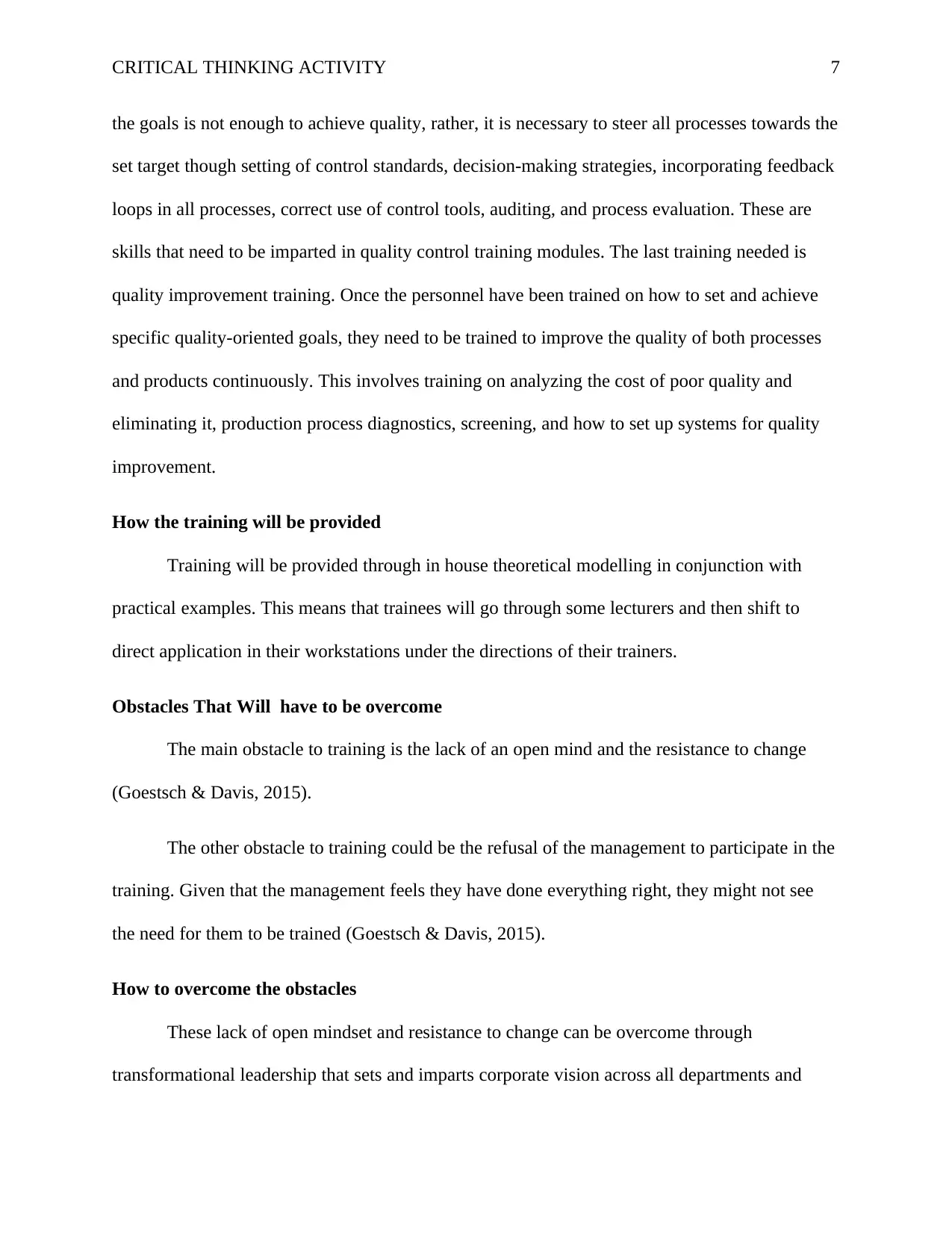
CRITICAL THINKING ACTIVITY 7
the goals is not enough to achieve quality, rather, it is necessary to steer all processes towards the
set target though setting of control standards, decision-making strategies, incorporating feedback
loops in all processes, correct use of control tools, auditing, and process evaluation. These are
skills that need to be imparted in quality control training modules. The last training needed is
quality improvement training. Once the personnel have been trained on how to set and achieve
specific quality-oriented goals, they need to be trained to improve the quality of both processes
and products continuously. This involves training on analyzing the cost of poor quality and
eliminating it, production process diagnostics, screening, and how to set up systems for quality
improvement.
How the training will be provided
Training will be provided through in house theoretical modelling in conjunction with
practical examples. This means that trainees will go through some lecturers and then shift to
direct application in their workstations under the directions of their trainers.
Obstacles That Will have to be overcome
The main obstacle to training is the lack of an open mind and the resistance to change
(Goestsch & Davis, 2015).
The other obstacle to training could be the refusal of the management to participate in the
training. Given that the management feels they have done everything right, they might not see
the need for them to be trained (Goestsch & Davis, 2015).
How to overcome the obstacles
These lack of open mindset and resistance to change can be overcome through
transformational leadership that sets and imparts corporate vision across all departments and
the goals is not enough to achieve quality, rather, it is necessary to steer all processes towards the
set target though setting of control standards, decision-making strategies, incorporating feedback
loops in all processes, correct use of control tools, auditing, and process evaluation. These are
skills that need to be imparted in quality control training modules. The last training needed is
quality improvement training. Once the personnel have been trained on how to set and achieve
specific quality-oriented goals, they need to be trained to improve the quality of both processes
and products continuously. This involves training on analyzing the cost of poor quality and
eliminating it, production process diagnostics, screening, and how to set up systems for quality
improvement.
How the training will be provided
Training will be provided through in house theoretical modelling in conjunction with
practical examples. This means that trainees will go through some lecturers and then shift to
direct application in their workstations under the directions of their trainers.
Obstacles That Will have to be overcome
The main obstacle to training is the lack of an open mind and the resistance to change
(Goestsch & Davis, 2015).
The other obstacle to training could be the refusal of the management to participate in the
training. Given that the management feels they have done everything right, they might not see
the need for them to be trained (Goestsch & Davis, 2015).
How to overcome the obstacles
These lack of open mindset and resistance to change can be overcome through
transformational leadership that sets and imparts corporate vision across all departments and
Paraphrase This Document
Need a fresh take? Get an instant paraphrase of this document with our AI Paraphraser
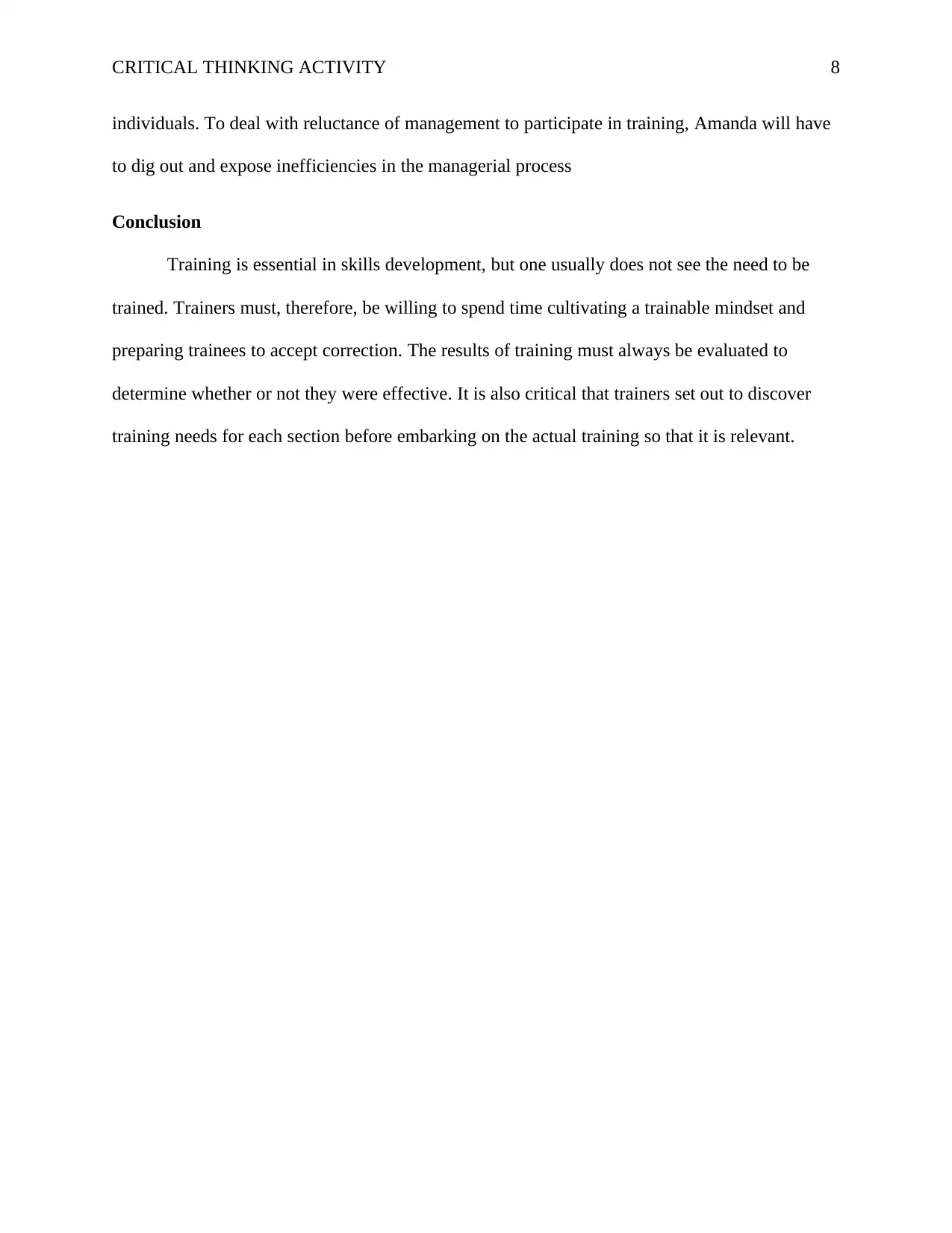
CRITICAL THINKING ACTIVITY 8
individuals. To deal with reluctance of management to participate in training, Amanda will have
to dig out and expose inefficiencies in the managerial process
Conclusion
Training is essential in skills development, but one usually does not see the need to be
trained. Trainers must, therefore, be willing to spend time cultivating a trainable mindset and
preparing trainees to accept correction. The results of training must always be evaluated to
determine whether or not they were effective. It is also critical that trainers set out to discover
training needs for each section before embarking on the actual training so that it is relevant.
individuals. To deal with reluctance of management to participate in training, Amanda will have
to dig out and expose inefficiencies in the managerial process
Conclusion
Training is essential in skills development, but one usually does not see the need to be
trained. Trainers must, therefore, be willing to spend time cultivating a trainable mindset and
preparing trainees to accept correction. The results of training must always be evaluated to
determine whether or not they were effective. It is also critical that trainers set out to discover
training needs for each section before embarking on the actual training so that it is relevant.
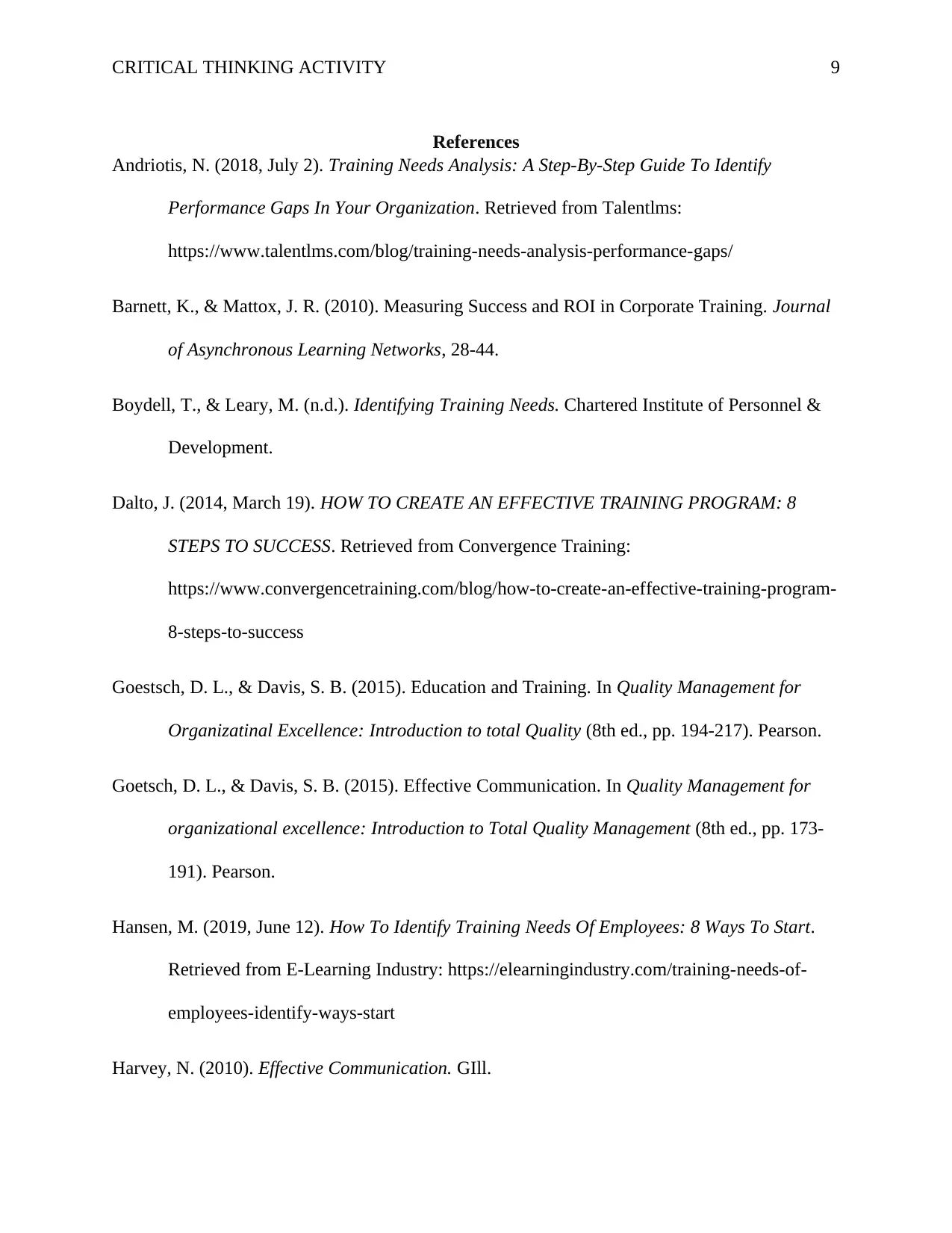
CRITICAL THINKING ACTIVITY 9
References
Andriotis, N. (2018, July 2). Training Needs Analysis: A Step-By-Step Guide To Identify
Performance Gaps In Your Organization. Retrieved from Talentlms:
https://www.talentlms.com/blog/training-needs-analysis-performance-gaps/
Barnett, K., & Mattox, J. R. (2010). Measuring Success and ROI in Corporate Training. Journal
of Asynchronous Learning Networks, 28-44.
Boydell, T., & Leary, M. (n.d.). Identifying Training Needs. Chartered Institute of Personnel &
Development.
Dalto, J. (2014, March 19). HOW TO CREATE AN EFFECTIVE TRAINING PROGRAM: 8
STEPS TO SUCCESS. Retrieved from Convergence Training:
https://www.convergencetraining.com/blog/how-to-create-an-effective-training-program-
8-steps-to-success
Goestsch, D. L., & Davis, S. B. (2015). Education and Training. In Quality Management for
Organizatinal Excellence: Introduction to total Quality (8th ed., pp. 194-217). Pearson.
Goetsch, D. L., & Davis, S. B. (2015). Effective Communication. In Quality Management for
organizational excellence: Introduction to Total Quality Management (8th ed., pp. 173-
191). Pearson.
Hansen, M. (2019, June 12). How To Identify Training Needs Of Employees: 8 Ways To Start.
Retrieved from E-Learning Industry: https://elearningindustry.com/training-needs-of-
employees-identify-ways-start
Harvey, N. (2010). Effective Communication. GIll.
References
Andriotis, N. (2018, July 2). Training Needs Analysis: A Step-By-Step Guide To Identify
Performance Gaps In Your Organization. Retrieved from Talentlms:
https://www.talentlms.com/blog/training-needs-analysis-performance-gaps/
Barnett, K., & Mattox, J. R. (2010). Measuring Success and ROI in Corporate Training. Journal
of Asynchronous Learning Networks, 28-44.
Boydell, T., & Leary, M. (n.d.). Identifying Training Needs. Chartered Institute of Personnel &
Development.
Dalto, J. (2014, March 19). HOW TO CREATE AN EFFECTIVE TRAINING PROGRAM: 8
STEPS TO SUCCESS. Retrieved from Convergence Training:
https://www.convergencetraining.com/blog/how-to-create-an-effective-training-program-
8-steps-to-success
Goestsch, D. L., & Davis, S. B. (2015). Education and Training. In Quality Management for
Organizatinal Excellence: Introduction to total Quality (8th ed., pp. 194-217). Pearson.
Goetsch, D. L., & Davis, S. B. (2015). Effective Communication. In Quality Management for
organizational excellence: Introduction to Total Quality Management (8th ed., pp. 173-
191). Pearson.
Hansen, M. (2019, June 12). How To Identify Training Needs Of Employees: 8 Ways To Start.
Retrieved from E-Learning Industry: https://elearningindustry.com/training-needs-of-
employees-identify-ways-start
Harvey, N. (2010). Effective Communication. GIll.
⊘ This is a preview!⊘
Do you want full access?
Subscribe today to unlock all pages.

Trusted by 1+ million students worldwide

CRITICAL THINKING ACTIVITY 10
Jones, R. G. (2016). Communication in the Real World: An Introduction to Communication
Studies. University of Minnesota Libraries Publishing.
Phillips, J. J., & Phillips, P. P. (2016). Handbook of training evaluation and measurement
methods. Routledge.
Sullivan, J. E. (2000). The Good Listener. Ave Maria Press.
Webmaster. (2016, Jully 16). Listening: 10 Traits of a Good Listener. Retrieved from Self
Improvemnt Box: http://www.selfimprovementbox.com/listening-10-traits-good-listener/
Jones, R. G. (2016). Communication in the Real World: An Introduction to Communication
Studies. University of Minnesota Libraries Publishing.
Phillips, J. J., & Phillips, P. P. (2016). Handbook of training evaluation and measurement
methods. Routledge.
Sullivan, J. E. (2000). The Good Listener. Ave Maria Press.
Webmaster. (2016, Jully 16). Listening: 10 Traits of a Good Listener. Retrieved from Self
Improvemnt Box: http://www.selfimprovementbox.com/listening-10-traits-good-listener/
1 out of 10
Related Documents
Your All-in-One AI-Powered Toolkit for Academic Success.
+13062052269
info@desklib.com
Available 24*7 on WhatsApp / Email
![[object Object]](/_next/static/media/star-bottom.7253800d.svg)
Unlock your academic potential
Copyright © 2020–2025 A2Z Services. All Rights Reserved. Developed and managed by ZUCOL.



